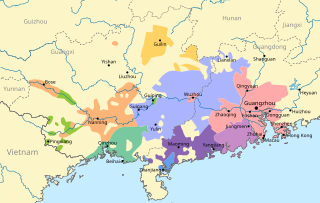| Siyi | |||||||||||||||||
|---|---|---|---|---|---|---|---|---|---|---|---|---|---|---|---|---|---|
| Seiyap, Sze Yup | |||||||||||||||||
| Native to | Guangdong, China; Sze Yup Chinese communities in Hong Kong, Southeast Asia and the Americas. | ||||||||||||||||
| Region | Sze Yup | ||||||||||||||||
Native speakers | 3.9 million (2010)[citation needed] | ||||||||||||||||
| Dialects |
| ||||||||||||||||
| Language codes | |||||||||||||||||
| ISO 639-3 | None (mis) | ||||||||||||||||
| ISO 639-6 | siiy | ||||||||||||||||
| Glottolog | siyi1236 | ||||||||||||||||
| Linguasphere | 77-AAA-mb | ||||||||||||||||
 Siyi (lower right), among other Yue and Pinghua groups in Guangxi and Guangdong | |||||||||||||||||
| Chinese name | |||||||||||||||||
| Chinese | 四邑方言 | ||||||||||||||||
| |||||||||||||||||
| Alternative Chinese name | |||||||||||||||||
| Chinese | 四邑話 | ||||||||||||||||
| |||||||||||||||||
Siyi (Seiyap or Sze Yup in Cantonese; Chinese: 四邑方言; pinyin: Sìyì fāngyán; Jyutping: sei3 jap1 fong1 jin4 meaning "Four Hamlets") is a coastal branch of Yue Chinese spoken mainly in Guangdong province, but is also used in overseas Chinese communities. Within the province, it is mainly spoken in the prefecture-level city of Jiangmen, but pockets exist outside Jiangmen, including the Doumen and Jinwan districts in Zhuhai, Guzhen in Zhongshan and Jun'an in Foshan. Taishanese, which was one of the most important Chinese dialects in Chinese American communities, is considered a representative dialect.
YouTube Encyclopedic
-
1/5Views:97 50314 90989 7934 558614
-
Cantonese vs Taishanese (ft. Inspirlang)
-
Yuehai Yue 粵海方言 (Guangzhou Cantonese 廣州話) Dialects
-
Indonesia Cantonese & Malaysia Cantonese (History of Cantonese vs Seiyap 四邑 Siyi dialect)
-
Yue (粵語) / Cantonese Language Comparison
-
Basic Conversational Taishanese 台山話會話
Transcription
Etymology
The name "Sze Yup" or "Seiyap" (Chinese: 四邑; pinyin: Sìyì; Cantonese Yale: sei yāp; lit. 'Four Counties') refers to the historical four counties of Jiangmen prefecture: Xinhui, Taishan, Enping and Kaiping.
Since a fifth county, Heshan, was added to the prefecture in 1983, this region is referred to as the "Five Counties" (Chinese: 五邑; pinyin: Wǔyì; Cantonese Yale: nǵh yāp) in the province; but for historical reasons, the term "Seiyap" is still used amongst the overseas Chinese communities.
It has also been called Delta Cantonese[1] because all the aforementioned counties are in the Pearl River Delta.
Geographic distribution
The Siyi dialect is mainly distributed along the drainage basin of the Tan river (Chinese: 潭江), as well as part of the region west of the main stream of the Xi River, near to the confluence of the two rivers. Most of the region in which Siyi is spoken is administered by the prefecture-level city of Jiangmen, including the Jiangmen city districts of Jianghai, Pengjiang and Xinhui, as well as the county-level cities of Taishan, Kaiping, Enping and the southeastern part of Heshan, but the dialect is also spoken in parts of Zhuhai, the town of Guzhen in Zhongshan and the town of Jun'an in Foshan. In terms of geographic extremes, Siyi is spoken furthest north in Yayao (雅瑶), Heshan; furthest south in Xiachuan Island, Taishan; furthest east in Hongqi (红旗), Zhuhai; and furthest west in Naji (那吉), Enping. The total geographic area of the region is approximately 9000 square kilometers and the total number of speakers is estimated at 3.9 million in 2010.
References
- ^ Luk, Bernard H. K. "The Chinese Communities of Toronto: Their Languages and Mass Media." In: The Chinese in Ontario. Polyphony: The Bulletin of the Multicultural History Society of Ontario. Volume 15, 2000. Start p. 46. CITED: p. 47 (Archive).
Further reading
- Cheng, Theresa M. (1973). "The phonology of Taishan". Journal of Chinese Linguistics. 1: 256–322.
- Lee, Gina (1993). Comparative, Diachronic and Experimental Perspectives on the Interaction Between Tone and the Vowel in Standard Cantonese (PDF) (Ph.D. thesis). Ohio State University.
- McCoy, John (1966). Szeyap Data for a First Approximation of Proto-Cantonese (Ph.D. thesis). Cornell University.

